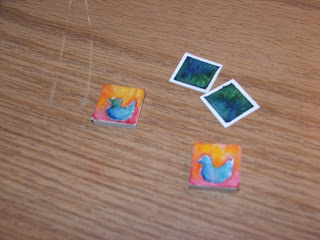There's a lot of beautiful jewelry out there. I can get caught up on
Etsy for hours and hours, just engrossed in all the wonderful ways people create jewelry. It truly is an art. That word right there, art, is the key to what I aspire to with my jewelry. I believe any necklace, earrings, ring, bracelet should be a unique and inspiring work of art.
One way to reach that goal, is to create interesting and innovative designs. Another way, however, is to create my own little art beads and charms. I have been working towards that with my scrabble tile charms and pendants. My next new idea is to create miniature watercolor paintings, which I will epoxy onto a shape and create a miniature mounted painting, which can strung on a necklace, or dangled from an earrings.
I am just in the beginning stages of this technique, but I am so excited about it, I just had to share the idea! I have a great deal of experience with watercolor painting. To see a collective gallery of my watercolor works, skip over to my art
website.
On a side note, I will also be testing out Diamond Glaze for this tutorial. Since this is my first time using it, I have come up with a lot of problems and am searching for solutions. Stay posted to learn more about my adventures with Diamond Glaze!
What's The Plan, Stan?
- I'm going to walk you through my initial process of creating these fun, original works of art, with additional information on paint and paper.
Ingredients:
- First of all, you will need watercolor paper
- A note about paper: you will quickly notice that realm of artist watercolor paper is vast, and rightfully so. Different kinds and qualities of papers will have different affects. Here are the basics:
- Cold press paper will have a more rough, more visible texture to it. This can be good or bad, depending on what you want.
- Hot press paper is the opposite, which a much smooth surface, and minimal visible texture.
- To begin with, student grade is fine, at least until you know if you like this idea or not.
- You will also, of course, need watercolor paints
- A note about paints: while I would not suggest buying a crayola watercolor paint pallet you should not spend a gazillion dollars on the firt project. Try a cheap boxed tube set for $6-$7 at Michaels
- For this adventure, we are going to work with two scrabble tiles to mount our pictures on. A - because we are (hopefully) already familiar with them, and we already have some (again, hopefully)
- If you have something else you can mount your paintings onto, by all means, try it out, and feel free to let me know how it went via cagarp@plymouth.edu
- Epoxy - there are tons out there but E9000 is a good one
- Mounting bail
- Diamond glaze, or similar
- Modge Podge to seal the painting
Tools Of The Trade:
- Fine round point watercolor brushes - synthetic work just fine
- Scissors
- Ruler
- Masking tape
- Watercolor pallet (you can get one for $.99)
- Art cloth - any clean old rag will do
- Mechanical pencil
Process:
- Carefully trace the scrabble tile on the watercolor paper, using a mechanical pencil. Make sure the lead is pressed right up against the tile.
- Next, keeping an extra boarder of about 1/2 inch, cut out the square.
- Tape down the paper, lining up the edge of the masking tape with the edge of the traced scrabble tile. Watercolor paper gets distorted as the fibers expand and soak up the pigment, but if taped down, it will shrink back to its normal shape.
- Paint your design/picture using whatever variety of watercolor techniques you know. Allow to dry completely. Remove the tape gently, so not to rip.
- Trim off the extra border around the painting.
- At this point, you may want to prep the scrabble tile. You could paint it, stamp it, do anything at all. Be creative! You may want to seal the scrabble tile with a coat of Modge Podge or lightly watered down craft glue.
- Attach the painting to scrabble tile using Modge Podge, or basic crafting glue.
- Turn the scrabble tile face down and trim off the extra paper.
- Seal top of painting with a coat of Modge Podge.
- Don't use watered down glue, as the water will cause the painting to smear.
- Epoxy the bail to back of the scrabble tile.
- Coat one side at a time with Diamond Glaze or Glossy Accents and allow to dry completely.
C'est Fin!
Bead Artist Showcase
Your work could be right here! Submit your own artwork beads to Creativity In A Nutshell via email to cagarp@plymouth.edu. Feel free to include pictures, anything new you tried and suggestions you have for improvement.
More Similar Fun Stuff!
Project: Scrabble Tile Jewelry
Tutorial: Scrabble Tile Pendants and Charms
















































